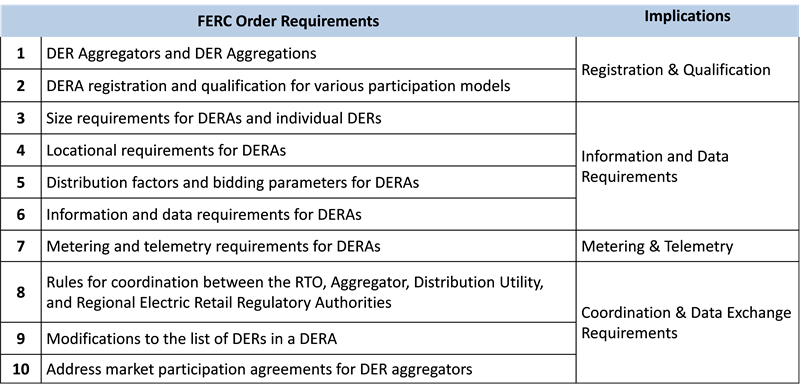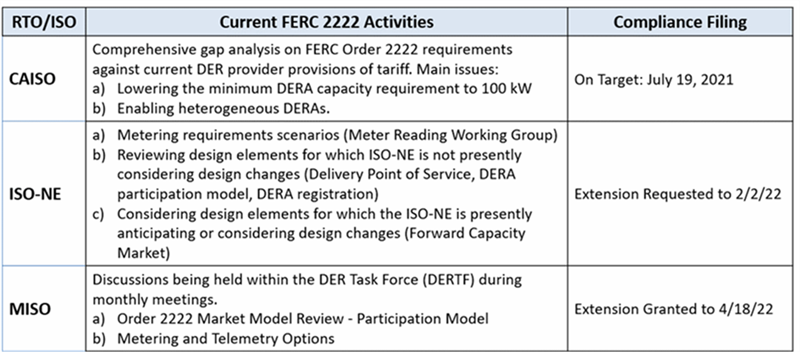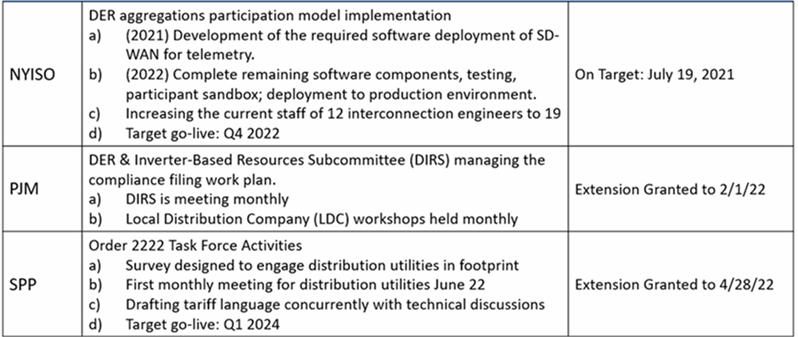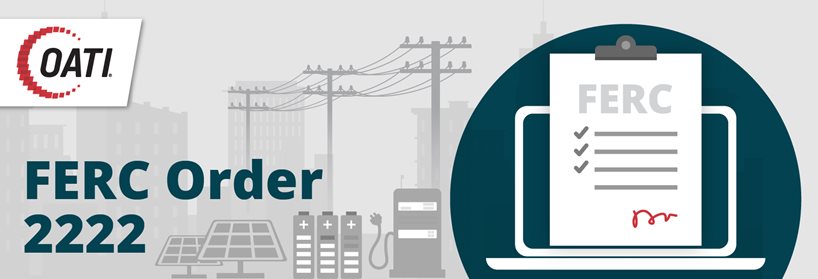Home » Blog » Grid Modernization » FERC Order 2222 – June 2021
FERC Order 2222 – June 2021
Background
Issued in February 2018, FERC Order 841 required ISOs/RTOs to allow energy storage assets to participate in ISO/RTO markets. This was expanded by Order 2222, issued in September 2020, allowing all types of DERs, including Demand Response, distributed generation, distributed storage, EV chargers, and Energy Efficiency, to participate in ISO/RTO markets and offer all market products they’re technically capable of providing. These market products include capacity, energy, operating reserves (spinning and supplemental), Frequency Regulation, and other products where applicable, such as Fast Frequency Response and flexible ramping. We think these landmark orders are as transformative as the FERC Orders 888/889 issued 25 years earlier for Transmission Open Access.
FERC Order 2222 explicitly sets forth ten requirements for ISOs/RTOs to comply with in implementing the Order. Summarily listed in the table below, we have grouped these into four sets with respect to implications on the functionalities needed to support the stated requirements.

ISO/RTO Status
FERC Order 2222 required FERC jurisdictional ISOs/RTOs to submit compliance filings no later than July 19, 2021. The single state ISOs/RTOs (CAISO and NYISO) are on track with this compliance filing. However, the multi-state ISOs/RTOs have all asked for delays of 7 to 9 months. The current ISO/RTO activities toward implementation of Order 2222 and their compliance filing dates are summarized in the table below as of June 10, 2021 (ERCOT is not FERC jurisdictional and thus has not been included in the table):


One of the reasons for delays in compliance filing of multi-state ISOs/RTOs is the need to coordinate with the individual states in their footprint.
Industry Status
A number of industry groups are holding stakeholder meetings in conjunction with FERC Order 2222. Noteworthy among them are NAESB and EPRI.
NAESB
Wholesale Electric Quadrant Business Practices Subcommittee (WEQ BPS) has been conducting regular meetings on FERC Order nos. 841 and 2222 since February 25, 2021. The objective is to develop and/or modify NAESB standards for information and reporting requirements to support battery storage/energy storage and, more broadly, distributed energy resources in front of and behind the meter. This item was added to the 2021 WEQ Annual Plan by the NAESB Board of Directors and is intended to provide support to the industry in the implementation of FERC Order nos. 841 and 2222. As part of this effort, the WEQ BPS is concentrating on three areas:
- Defining an index/registry
- Creating information and reporting requirements
- Establishing performance metrics
EPRI
TSO-DSO Working Group, which formed a couple of years ago, shifted its attention to FERC Order 2222 after September 2020. The group holds weekly meetings on Tuesdays from 10:00-11:00 AM PST. Participants include individuals from ISOs/RTOs, utilities, PUCs, DOE Labs, universities, consultants, and vendors. Current discussions mainly focus on two topics:
- DER parameters
- Dual Participation
OATI Status
OATI has been actively following and working on the industry activities pursuant to FERC Order 2222 by conducting webinars, assessing industry requirements, and initiating internal development activities to address key operational requirements of the Order. OATI has started an Industry Advisory Group composed of key customer representatives to review emerging requirements and guide new developments. OATI will continue to accelerate the efforts to ensure solutions are ready for customers as applicable.
The concept of Virtual Power Plants and supply of grid services, also known as market products, by aggregated DERs has been deployed and demonstrated across the industry for the past several years. The OATI DERMS has been the platform for such application on a number of projects, some of which have characteristics very similar to the requirements of FERC Order 2222. Some examples include the supply of regulation services from a fleet of electric vehicles, along with the supply of reserves and fast frequency response from aggregation of a heterogeneous set of resources, including residential water heaters, residential PV-battery systems, and large scale C&I battery storage assets. The deployed functionality spanned from registration and enrollment to capability forecasting, metering and telemetry, scheduling, dispatch and control, performance assessment, and stakeholder settlements and dispute management.
Among OATI’s new activities to address post FERC Order 2222 requirements include the development of transactional management capabilities for operational coordination amongst aggregators, DSOs and ISOs/RTOs; management of DER reference data; and assessment and further enhancements to support emerging use cases.
Please keep your eye on the OATI FERC Order 2222 monthly blogs to gain further insights into the associated operational and technical requirements. We will be sure to cover the status of the ISO/RTO compliance activities, industry initiatives and developments, and issues and approaches among other current developments.
For more information, please contact FERCOrder2222@oati.net.
- June 17, 2021
